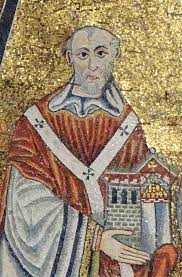
Pietro Pierleoni was born in Rome around 1090, the second son of the extremely rich and well-known Pier Leoni. As such, he was expected to raise through the ranks of the Church. One thing against his success was that his great grandfather, Baruch, or Benedictus, was a Jew who converted. The other circumstance was that the Pierleoni and Frangipani families were enemies.
As a young man, Pietro went to Paris to study. Afterwards, he entered the Benedictine monastery at Cluny. At a young age, he was consecrated cardinal-deacon of the Church of Sts Cosmos and Damian. He became a cardinal when Pascal II raised him in 1116. He accompanied Pope Gelasius as he fled from the Frangipani to France in 1118. And he was one of the cardinals who elected Callixtus II at Cluny in 1119. By 1121, he was a papal legate to England and the following two years he was papal legate to France. He was definitely an opponent of imperial investiture of clerics, as was Callixtus. It appears that Pietro’s father’s money had a lot to do with the pope and the curia returning to Rome at the end of Callixtus’ reign.
Two Popes on the same day
In early February, 1130, Pope Honorius III was dying. The chancellor, Aimeric, had him whisked to the monastery of St Gregory, near the Frangipani home. Here he died the night of 13 February and the cardinals quickly buried him. Cardinal Gregory Papareschi reluctantly accepted the nomination of a small number of cardinals, taking the name Innocent II. And, within hours, the larger number of cardinals nominated Pietro on the other side of town. He took the name Anacletus II. Both men were consecrated on the same day, 23 February, in two different places. Anacletus was supported by most of the clerics, nobles and people of Rome. Then, the Frangipanis, seeing that they were likely to lose their social position by supporting the wrong man, decided to join with the new Pope Anacletus. Pope Innocent had to leave town.
Months later, when Innocent had begun to get the European rulers to back him, there was a council at Etampes, organized by King Louis VI of France. He and other rulers chose Innocent as the “real” pope, urged on by St. Bernard of Clairvaux, Peter the Venerable and others.
Anacletus, over the next few years, lost supporters. Because his family was fabulously rich, he used his wealth to buy support. He is said to have plundered the churches to add to his treasury. Rumors about his Jewish ancestor blackened his reputation. He bolstered his support by writing a bull declaring Roger of Sicily the king of that island nation. Another supporter was Duke William X of Aquataine.
In 1134, the Council of Pisa excommunicated Anacletus. But the anti-pope hung on to his power in Rome. In 1138, he died. Immediately, the cardinals elected another anti-pope , who took the name Victor III. Saint Bernard of Clairvaux stepped in again and talked Victor into giving up his claim to the throne. Innocent, then, was able to return to Rome.
The brother of Anacletus, Giordano Pierleoni, was the leader of the commune of Rome. He probably had much influence on the city, keeping Anacletus’ reign going for much longer than it should have lasted. He actively opposed Innocent’s successors during the next decade.
Recent research has modified the attitude historians have towards Anacletus. Maybe he was not so bad.
External links: https://www.catholic365.com/article/18816/anti-pope-anacletus-ii.html
Internal links: https://www.lanternariuspress.net/pope-innocent-iii/

Recent Comments